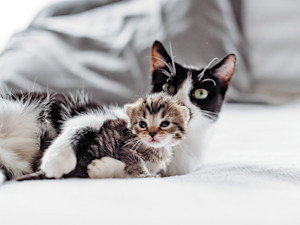Welcome to the Jungle: How to Introduce a New Cat to Your Pets
Feels high stakes because it kind of is.
Just a few decades ago, family pets mostly came and went as they pleased, keeping their visits pretty closely confined to mealtimes. This lifestyle presented its own challenges (shorter lifespans, overpopulation of cats and dogs) but it was, in a word: simple. These days, pets are bona fide family members, which means they might live in close quarters with another furry sibling or two. The dynamics, anyone in this situation will attest, can be complex.
If you’ve recently added a new cat to the fam — and you already have a cat (or dog) — you should know that the first six weeks are critical. This time sets the stage for their relationship with you, other housemates, and resident pets. It’s an exciting time, but one that you’ll want to keep as under control as possible. Thankfully, we’ve got a surefire four-step process that will help you do just that.
Phase 1: Nothing to see here.
During the first 48 hours (or longer if your new kitty is extra shy), your resident pets need to contain their excitement because New Kitty will be hanging out in a safe room with all the supplies they need and no interruptions from other animals.
Whether it’s a bathroom or spare bedroom, they need time to get used to the sounds and smells of your house without a dog chasing them or another cat hissing from around a corner. Set up this “safe room” before you bring them home, then cover the cat carrier with a towel or blanket before you walk inside. Don’t try to rush them out of the carrier: They’ll come out when they’re ready. Humans are allowed to spend as much time with them as they’d like, starting to build a bond through play.
How much do you spend on your pet per year?
Phase 2: Look, but don’t touch.
In this phase, resident pets can start to get a peek at the new cat. Like at a crowded party, we want these interactions to be short and sweet with hors d’oeuvres served for good behavior. Place a baby gate across the doorway of the safe room. Before you open the door for initial greetings through the gate, arm yourself with treats, and in the case of a resident dog, put a leash on to help control any potential chaos. Don’t force anyone to interact. If the new kitty wants to hide under the bed while your pup looks into the room, that’s ok. Trust us. Your dog knows there’s a cat in there whether they can see them or not.
The goal here is boredom. If your new cat is confident, toss some treats behind them so they’ll retreat while you treat your resident cat or dog for good behavior. We’re looking for relative calm here. If the party gets too loud, make like your parents and shut it down. If someone explodes, calmly end the session, try to keep things shorter next time, and don’t skimp on the treats when your resident pet remains calm.
Phase 3: Meet the middle manager.
Over the next few weeks, you’ll micromanage everyone in the house: No chasing or over-the-top barking. Have your dog drag a leash around the house so you can easily stop them from practicing any attempts to terrorize the new cat, and reward them with treats when they come to you instead. (Pro tip: It helps a lot to keep your resident pets tired during the first six weeks. Add an extra day of doggie daycare, a dog walker, or more dedicated playtime with your resident pet. If said resident is another cat, keeping separate food and litter box areas will help decrease potential conflicts. During this phase, your new kitty heads back to the safe room anytime you can’t keep an eye on things, like when you’re making dinner or need to run an errand.
Phase 4: The new normal (ish?)
It has been a few weeks, your dog has stopped chasing the new cat, your resident cat has begrudgingly accepted that there’s a new cat in town, and you think they’re ready for some unsupervised fun. Like the first time your parents let you go to a party with friends, hope for the best, but prepare for a possible grounding. Keep your outings out of the house short and stay close by. Remember that baby gate? If your resident pet is larger than the new cat, raise it up a few inches so they can retreat into the room if necessary. Tire everyone out as best you can before the first unsupervised party. As everyone gets used to the new routine, you can increase the time you’re away.
It may seem like a lot of effort, but our pets look to us for safety. If you do your part to make the introduction a smooth one, it will set the standard for a happy, healthy life at home.








